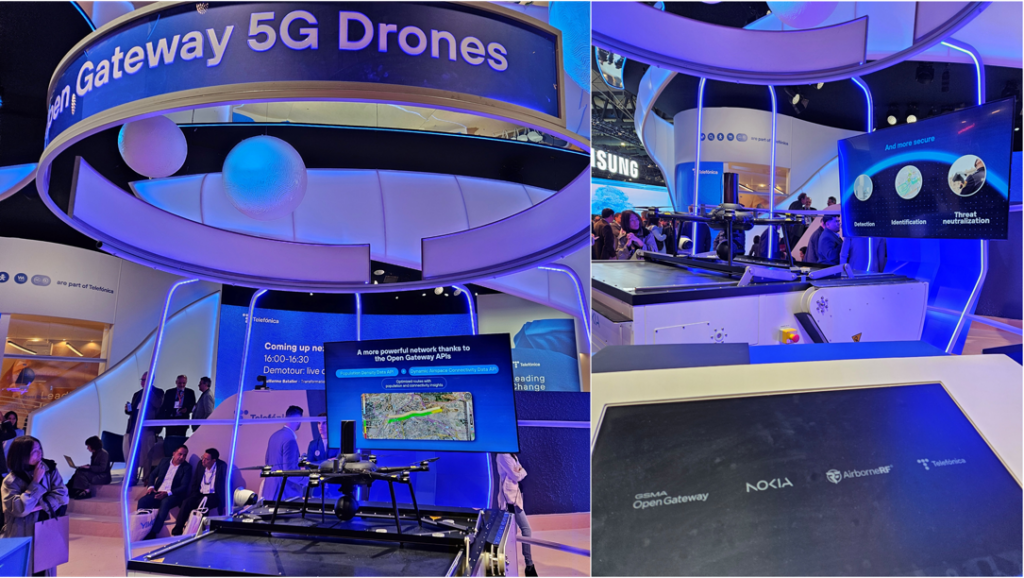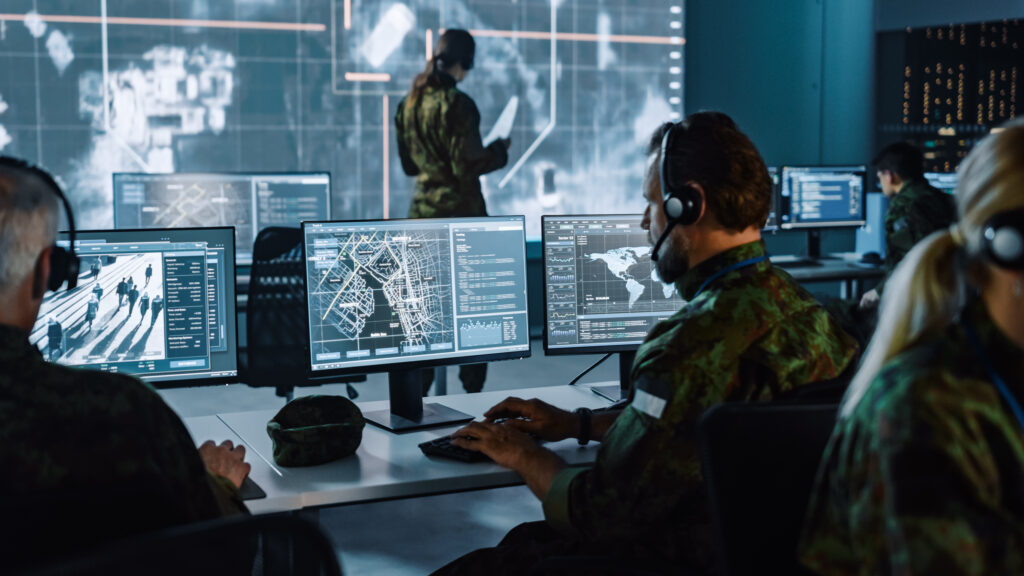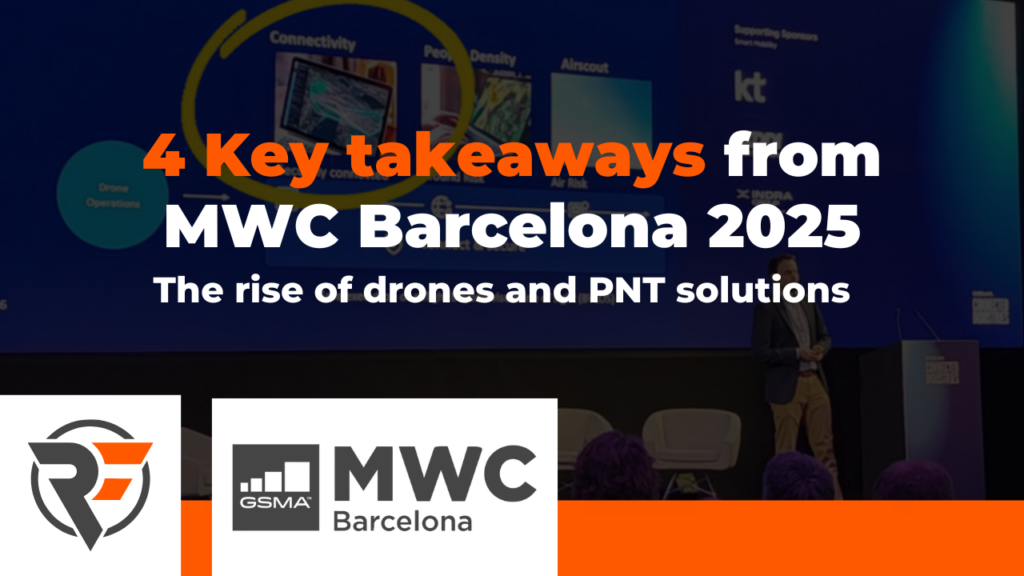At MWC Barcelona 2025, two key trends stood out: the growing integration of drones with telecom networks and the increasing importance of PNT (Positioning, Navigation, and Timing) solutions. As mobile networks become essential for BVLOS (Beyond Visual Line of Sight) drone operations, especially for enterprise industry driven end to end and DFR – Drone as First Responder solutions, assurance of PNT technologies is becoming an increasingly important objective, due to increasing GNSS (global navigation satellite systems) vulnerabilities such as spoofing and jamming.
1. Telecoms and drones are coming closer together
A major topic at MWC 2025 was how telecom operators are rapidly becoming key enablers of drone operations by utilizing their already existing infrastructure providing solutions for end customers. Mobile networks are now at the core of aerial connectivity, allowing drones to operate safely, efficiently, and at scale.
- Telefonica’s integrated end-to-end drone solution
Telefonica showcased a fully integrated drone ecosystem, proving how telecom networks – powered by platforms like AirborneRF – can deliver real-time airspace connectivity, risk assessments, and flight automation. AirborneRF plays a key role in enabling this level of integration by transforming mobile network data into aviation-grade insights, supporting BVLOS operations and end-to-end automation at scale.

- T-Mobile & Vodafone: Drones as flying base stations
T-Mobile and Vodafone demonstrated how drones can act as mobile base stations, extending network coverage to remote areas and disaster zones.
- Swisscom’s cutting-edge drone services
Swisscom introduced its advanced drone operation concept, featuring AirborneRF as a key enabler for BVLOS flights, supporting applications such as infrastructure inspections, logistics, and emergency response.

- Drones for emergency & commercial use cases
Multiple telecom operators showcased various drone innovations, including:
- Drone as a First Responder – a major focus at MWC, with telcos providing the connectivity and AI-driven insights needed to scale these operations.
- Life-saving medical drones
- Drone taxis for urban mobility
2. AirborneRF: A key enabler for MNO services in the drone industry
MNOs have a broad range of capabilities that can be specifically tailored to meet the unique demands of UAS operations. These go beyond basic connectivity, offering enhanced services that ensure safe and scalable drone operations, all the way to becoming some of the largest drone operators themselves.
Dimetor with AirborneRF is at the heart of this transformation, bridging the gap between telecommunications and aviation. By integrating dynamic data from mobile networks, AirborneRF provides essential insights for BVLOS drone operations, ensuring they are safe, reliable, and compliant with aviation regulations.
Through AirborneRF, MNOs can offer the following revenue-generating services:
- Connectivity insights – Real-time network quality information along flight paths, ensuring seamless BVLOS operations.
- Ground risk assessments – Dynamic population density and risk analysis to help operators adjust routes and meet compliance standards.
- Real-time alerts – Integrated UTM connectivity for instant network updates, keeping flights secure.
- GNSS-independent positioning – Alternative UAV positioning data, providing an extra layer of redundancy in the airspace.
By enabling these services, AirborneRF unlocks new revenue opportunities for telecom operators while ensuring safe and efficient drone operations at scale.
3. PNT assurance solutions are becoming more important
Positioning, Navigation, and Timing (PNT) technologies are foundational for the operation of modern drones and various industries, enabling precise location tracking, seamless navigation, and synchronized timing for systems and networks. PNT is thus at the core of efficiency, safety, and performance across applications such as aviation, transportation, telecommunications, and defense.
At MWC, rising threats like GPS spoofing and jamming emphasized the urgent need for alternative and secure PNT systems. While many exhibitors focused on military-grade interference detection systems, Dimetor showcased NAVSentry as a more accessible, scalable, and commercially viable solution for both military and civil sectors. This shift from hardware to data-driven detection represents a turning point in how the industry approaches GNSS security.
During MWC Barcelona there were more and more examples of Assurance and redundancy solutions. Companies such as Rohde & Schwarz, Spirent,4 Viavi, and Anritsu unveiled technologies that monitor signal integrity, provide dedicated hardware/software solutions to detect spoofing attempts, and provide multi-layer assurance and mitigation capabilities.
NAVSentry by Dimetor stands apart from traditional GNSS interference detection tools by leveraging mobile network data – rather than bulky, expensive military-grade hardware. By creating a virtual sensor network, NAVSentry detects spoofing and jamming events in real-time and across large areas, providing scalable and cost-efficient assurance. This is especially valuable for commercial and civilian drone operations that cannot rely on high-cost defense tools.
Most interference detection systems today are designed for military use—expensive and inaccessible. NAVSentry changes that by providing scalable, cost-efficient monitoring using telecom infrastructure.

4. Dual-use of 5G and associated technologies
The discussion around 5G’s role in both commercial and defense sectors gained major momentum at MWC 2025. Dual-use telecom infrastructure is becoming increasingly relevant as nations seek to modernize their defense communications using for example private instances and networks of commercial 5G tech.
- Private 5G for defense – Governments and military organizations are deploying standalone 5G networks to enhance command-and-control capabilities, secure communication channels, and support unmanned operations such as autonomous vehicles and drones.
- Commercial 5G for strategic use – Beyond private networks, experts examined how public 5G infrastructure can be adapted for defense use. The emphasis was on network slicing, ultra-low latency, and end-to-end encryption, enabling seamless communication even in contested environments.
This dual-use paradigm opens up massive market potential for the telecom industry, signaling a convergence of national security priorities with commercial telecom innovation.
5. 6kg of Mozart Chocolate is not enough

We thought 5kg of Mozart Chocolate would be enough for MWC… we were wrong! The demand for Austrian chocolate at our stand was overwhelming, proving that sometimes, the best way to engage at a tech conference is through sweets. 😊
Final thoughts: What’s next?
MWC Barcelona 2025 confirmed that drones and telecom networks are merging faster than ever. Whether it’s enabling BVLOS flights, ensuring PNT security, or integrating 5G for dual-use applications, telecoms are playing a pivotal role in the future of aerial mobility.
We are no longer asking whether telecom data is relevant to aviation, we are proving it is the backbone of next-generation aerial operations.
At Dimetor, we’re excited to be at the forefront of this transformation, helping MNOs, drone operators, and aviation authorities build the connected skies of tomorrow.
Want to learn more? Visit dimetor.com.

